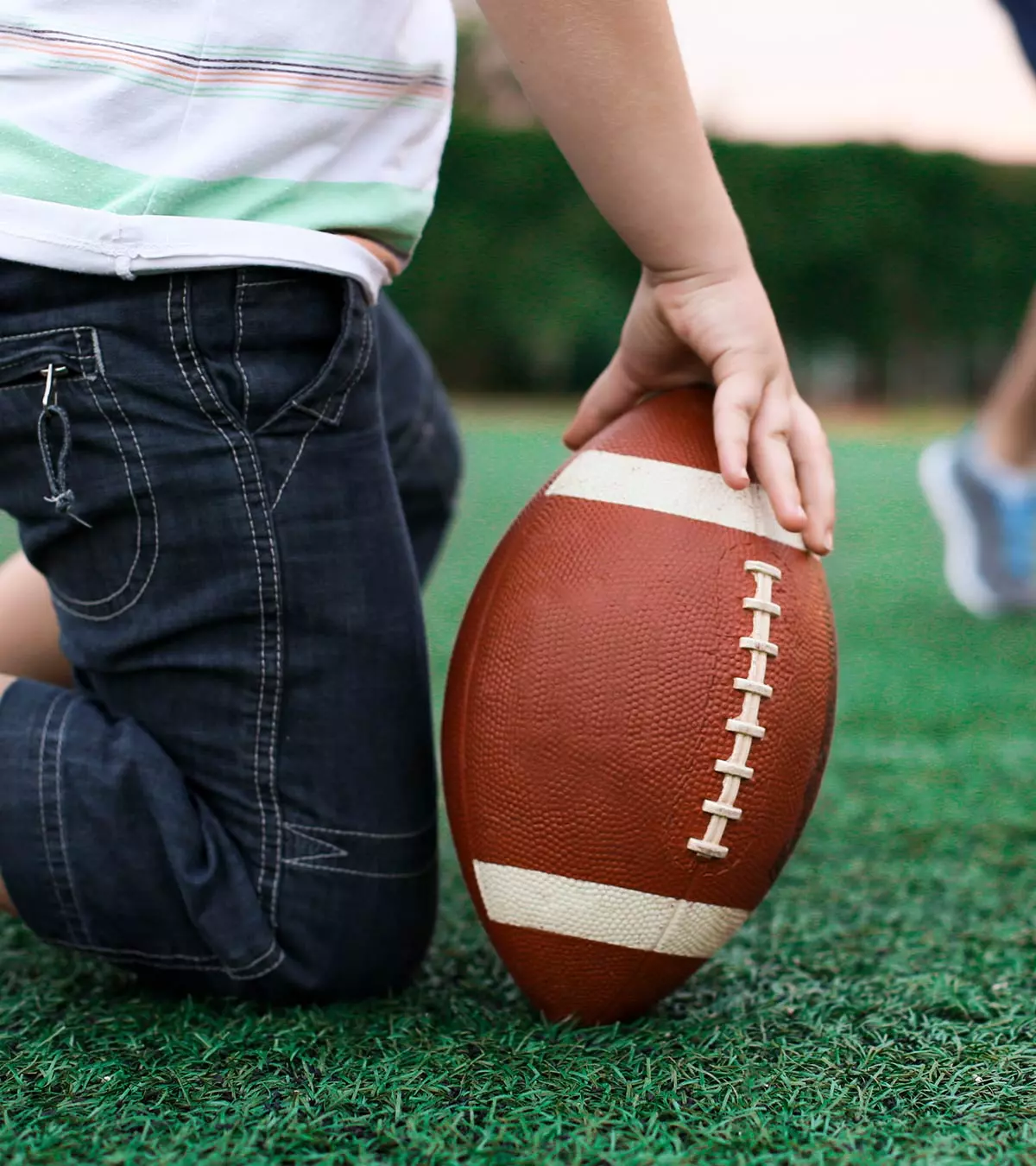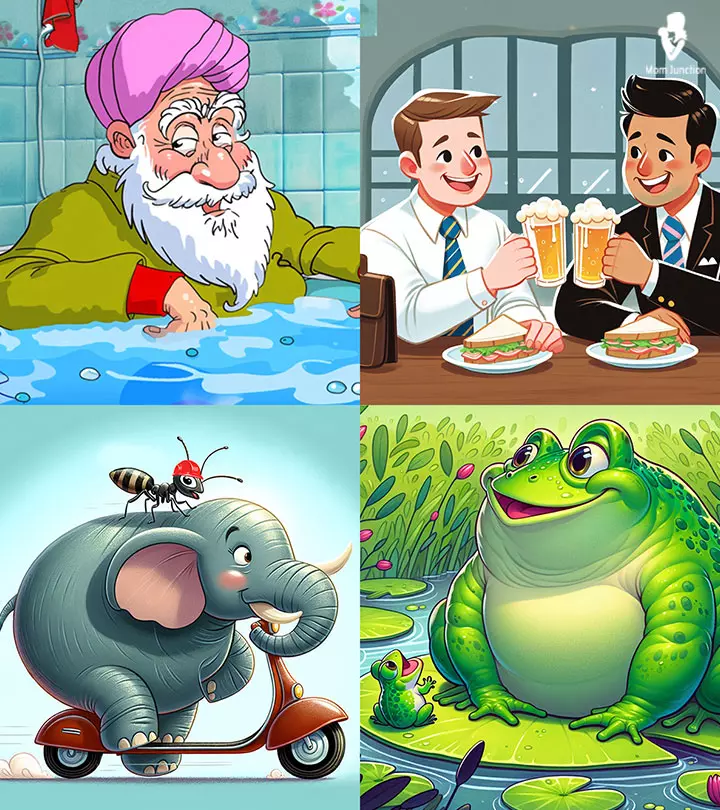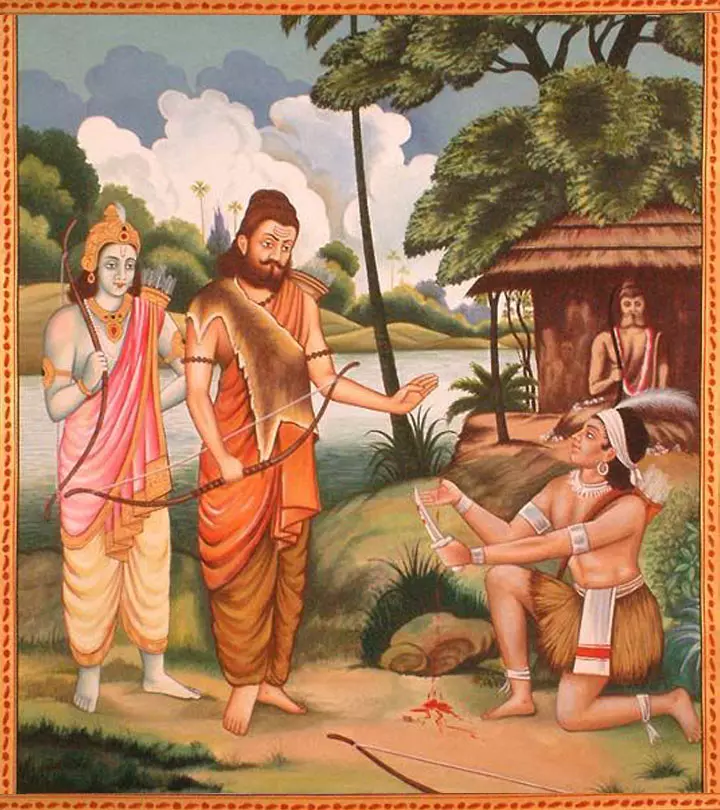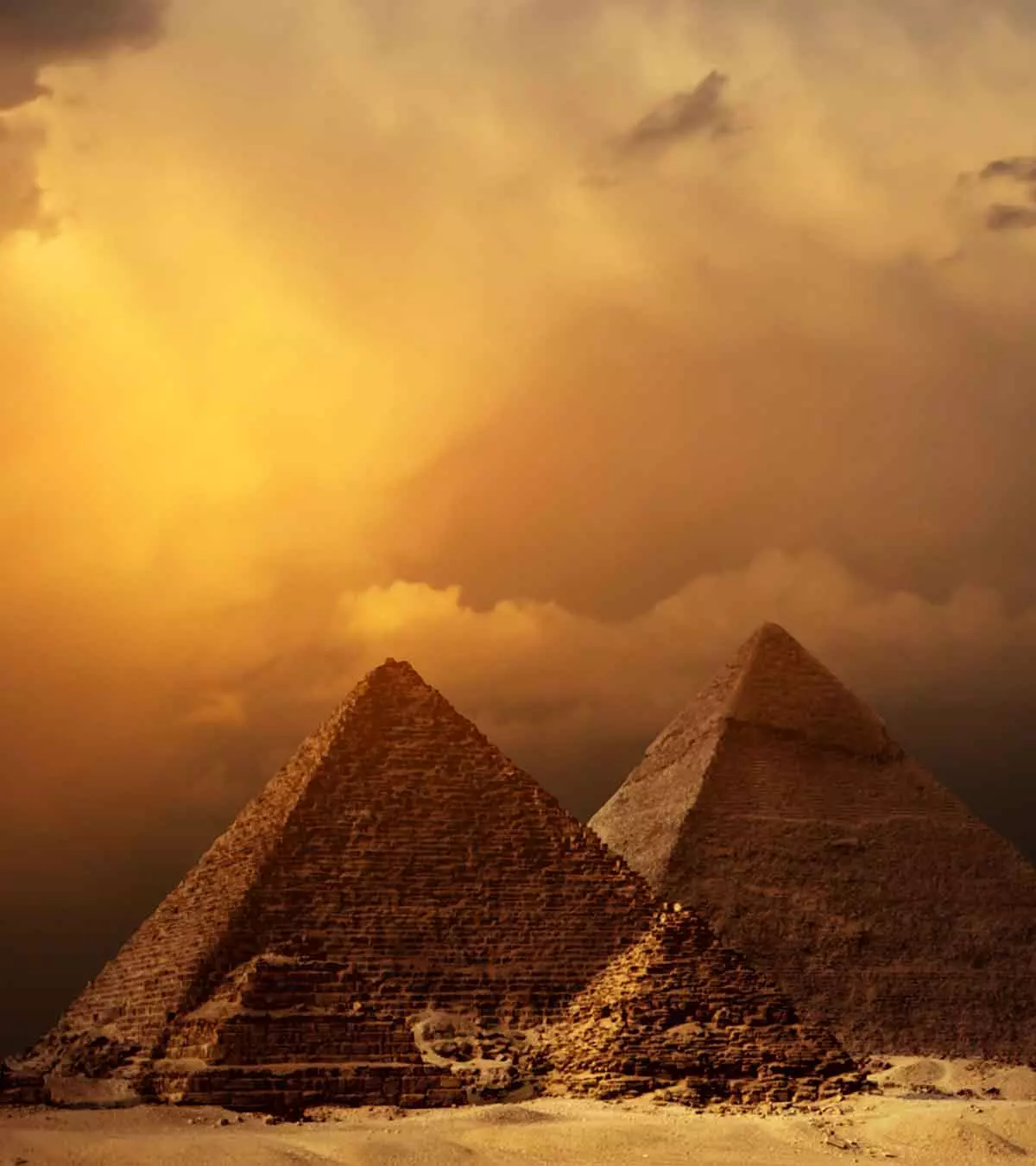
Image: ShutterStock
The sight of a little, colorful lobster swimming in an aquarium frequently draws children’s attention. If they wish to learn more about these marine creatures, why not share some fun lobster facts for kids with them. Your little one can learn about this fascinating aquatic arthropod’s structure, life, and other characteristics.
Learning about this small aquatic creature will pique your child’s interest while expanding their knowledge of marine life. Here are some interesting lobster facts for children; read on!
Key Pointers
- Lobsters are a type of crustacean with ten legs, belonging to the family Nephropidae.
- They are not fish, but invertebrates that lack a backbone.
- A lobster’s anatomy is divided into a head, a mid-body portion, and an abdomen that is further divided into six pieces for flexibility and movement.
- Lobsters are omnivorous and feed on fresh crabs, starfish, mussels, and other aquatic invertebrates.
- They have a remarkable lifespan of over 100 years and can grow to more than three feet in length.
21 Interesting Points On Lobsters For Kids
1. What Are Lobsters?
Lobsters are one of the most popular crustaceans who belong to the family of Nephropidae. They are invertebrate arthropods, who possess hard protective exoskeletoniThe animal's exterior skeleton that supports and shields its body and no backbone. They have ten legs making them famous as ‘decapods’. Typically, lobster means American lobsters. There are about 49 species of these invertebrates present in various oceans throughout the world. Out of the 49 species of these crustaceans, 33 species are in commercial applications. Fishermen catch around 200,000 tons of lobsters every year. In spite of this, lobsters are not yet on the list of endangered species.
2. Is A Lobster A Fish?
No, lobster isn’t a fish. Kids often get confused with this. However, the fact is that lobsters do not belong to the fish species. Fishes are aquatic vertebrates while lobsters are invertebrates that lack backbone. Unlike fishes, a lobster’s body comprises many pairs of legs, and is made up of various sections enclosed in a hard outer shell.
 Did you know?
Did you know?3. Where Do Lobsters Live?
American Lobsters are found on the Atlantic Ocean’s coast of North America, Labrador, Canada, and Cape Hatteras and in all other oceans too (1).
- Lobster lives in fresh and brackish wateriWater that is not as salty as salt water but saltier than fresh water . So you can find them in any waterbody.
- These crustaceans like to live in the mud and murk at the bottom of the sea.
- Lobsters live singly making their homes in the crevicesiA small crack or aperture, particularly one in a rock or wall and the burrows present on the seafloor and under the rocks where they can hide from predators.
- Young lobsters make the holes in pebbles, sand, and clay as they find it difficult to locate a gravelly environment.
- You can also find them beyond the edge of the continental shelf (2).
4. What Is The Anatomy Of A Lobster?
Like most arthropods, a lobster’s body is bilaterally symmetrical. The body of a lobster comprises two main sections:
- Cephalothorax (Head): The cephalothorax of a lobster contains the cephalon (i.e. head) and thorax (i.e. mid-body section), considered to be the body. A hard shell called carapace covers the body. As many as 14 segments, called somites, fuse together to make the cephalothorax. Also, cephalothorax of a lobster comprises its claws. One of the claws having the sharpest and largest pincers is called the pincer claw, and the other is the crusher claw. Crusher claw is the most powerful claw of the crustacean as it crushes the shell of the lobster’s prey with it.
- Abdomen: Abdomen is another major part of a lobster’s body. It comprises six sections which do not fuse to enable excellent flexibility and movement of the crustacean. First, five segments of the abdomen bear swimmerets, and they are beneath the tail. The sixth part comprises the tail fan. Lobster can contract and retract its tail quickly and forcefully and move backward.
5. What Do Lobsters Eat?
Lobsters are omnivorous, capable of eating anything that their claws get on, no matter if it’s alive or dead
. But they prefer to eat fresh food. Here, we list some of the common foods of lobster:
- Lobsters prefer crab, starfish, mussels, sea urchins, mollusks, clams, and marine worms prominently.
- They catch and eat fast-swimming aquatic creatures, such as shrimps, sand fleas, and small fishes.
- Although lobsters prefer to eat animals, the scarcity of marine animals in their environment in the spring can make them thrive on aquatic plants and sponges to obtain energy.
- Lobsters do not eat their species; if you heard they are cannibals, then it’s a myth.
- A lobster may consume a part of its old shell to get enough calcium to make its new exoskeleton healthy.
6. Can Lobsters See?

Lobsters possess poor eyesight. In fact, deep-sea lobsters are often blind. Some species of the crustacean tend to have compound eyes. However, they can view a clear image. With a strong smelling sensation they can detect movements even at night. Lobsters are nocturnal creatures, so they are more active at night.
7. Are Lobsters Left-Handed Or Right-Handed?
Just like humans, lobsters are both left-handed and right-handed. Depending on the position of the crusher claw at the left or right side of the lobster’s body, you determine whether it’s left-handed or right-handed.
 Did you know?
Did you know?8. Do Lobsters Taste Food With Their Legs?
Yes, the feet and legs of the lobsters are chemosensory. Chemoreceptors are present on the small antennae in front of the eyes of the crustacean that helps it in tracking down the food by detecting distant chemical signals and odors that flow with the seawater.
9. Do Lobsters Have Three Stomachs And Teeth In Their Stomachs?
The digestive system of a typical American lobster comprises three stomachs:
- Foregut: Foregut, the first stomach, includes a gastric mill with a set of teeth for grinding the eaten food into fine particles which pass into its midgut. Having teeth in the stomach is an interesting fact about lobster.
- Midgut: Midgut, the second stomach, promotes the digestion of fine food particles with the help of tomalley glands, the green colored area.
- Hindgut: Large food particles which midgut cannot absorb go into the hindgut, and then excreted through the enlarged rectum anus.
10. What Are The Types Of Lobsters?
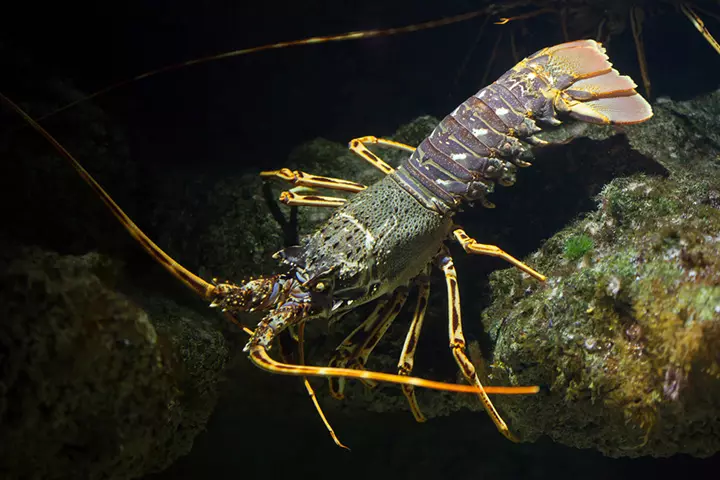
There are two main groups of lobsters, namely clawed and spiny lobsters.
- Clawed Lobsters: This class of crustaceans possesses claws, and they usually prefer staying in cold water environments.
- Spiny Lobsters: Spiny lobsters are also popular as rock lobsters. This group of invertebrates has long antennae in place of claws and spines over their entire bodies, and they thrive in warm tropical and subtropical waters and rocky reefs.
11. What Is The Color Of Lobsters?
Live lobsters are not red in color. They turn red only when you cook them as the heat breaks the protein bonds, releasing astaxanthiniRed antioxidant pigment that is part of substances known as carotenoids and found in algae, yeast, and certain fishes from its shell. Usually, lobsters are olive green or greenish brown in color. You can also find orange, dark green, reddish, or black speckles on the body of this crustacean, blue color at its joints.
 Quick fact
Quick fact12. Do Lobsters Grow Forever Till They Die?
Lobsters continue eating their food, reproducing, and growing physically throughout their lifespan. Like other crustaceans, lobsters don’t have a fixed size limit as they continue to increase till they die. They grow by molting their exoskeleton. An average lobster molts 44 times before it turns one-year-old. Up to seven years, lobsters molt once in a year. After it turns seven, a lobster molts once in two or three years growing larger in size after shedding its exoskeleton.
13. What Is The Largest Size Of Lobster?
Records reveal that the fishermen caught the largest lobster, popular as ‘Big George’ in 1974 in Cape Cod, which was about 2.1 feet in length and 37.4 pounds in weight. Later, the fishermen caught the biggest lobster of 3.5 feet long in Nova Scotia in 1977, and its weight was 44 pounds and six ounces. In 2013, fishermen caught a lobster of 27 pounds in Maine which was approximately the size of a toddler.
14. How Does A Lobster Reproduce?
Reproduction in lobsters involves the laying of eggs, which the female carries until they are ready to hatch. After mating, fertilization of the eggs occurs immediately. Like fishes, eggs of a lobster are also popular as roe. Depending on the warmth of the water, a female lobster carries the eggs for about a year in its swimmerets. However, quite a little percent of eggs i.e. only 0.1 percent of eggs reach maturity. Out of 10,000 eggs, just ten eggs will survive for greater than six weeks. The black line present of the tail of the crustacean contains unfertilized eggs that you can eat.
15. Do Lobsters Scream In Pain When You Cook Them?
No, lobsters do not scream; it’s a myth. Lobsters have no throat and no vocal cords to emit noise. The sound that you hear while cooking them is the trapped air in the stomach which gets out with force through their mouth while you cook them. You may listen to the noise for a minute or two after you put the crustacean in a pot of boiling water.
16. Can A Lobster’s Claw Exert Tremendous Pressure?
Crusher claw, one of the claws of a lobster, can exert a pressure of about hundred pounds per square inch. The claw can clamp down a pressure measuring device. This powerful claw possesses molars as it can easily break up hard creatures, such as crabs, mussels, and clams. Lobsters can cause severe pain to others without feeling any pain. The ripper claw tears off the soft fishes and worms.
17. Can A Lobster Regenerate Its Limbs?
Yes, a lobster can regenerate its limbs, and the process is known as reflex amputation or autotomy. Lobsters discard their legs as a survival phenomenon and regenerate them. They can regenerate claws, legs, and antennae as they have a primitive nervous system and differential sensitivity to pain. However, it takes a long time, i.e. about five years, for a pound of lobster to regenerate its lost claw.
18. Can You Make Golf Balls Out Of A Lobster’s Shells?
Usually, the leftover shells of a lobster are put into the landfills. However, golf balls can be made out of them. The core of the balls comprises the lobster shells, which are biodegradable. You can use them for golfing on courses near the water bodies and onboard cruise ships.
19. Why Are Lobsters Popular As Go-To Prison Food?
In the colonial times, prisoners and poor servants used to eat lobsters as they were inexpensive and available in plenty. Also, people used to find them tasteless. However, today, people make various recipes by cooking lobsters, and it’s no longer a poor man’s food.
20. How Nutritious Are Lobsters?
Lobsters carry a high nutritional value. Their meat is a rich source of proteins, for a cup of meat provides you about 28 grams of proteins. Also, lobsters have omega-3 fatty acids that boost cardiovascular health when included in the diet. Just three and a half ounces of lobster meat without butter offers you 96 calories and two grams of fats that prevent you from putting on weight and help you stay in shape.
21. How Long Do Lobsters Survive?

Lobsters can survive up to 100 years. However, a significant number of them have a short lifespan as they end up in the fishing nets trap.
Types Of Lobsters
There are various species of lobsters, with the most commonly known being the American lobster or Homarus americanus and the European lobster or Homarus gammarus. The American lobster, found in the Atlantic Ocean, is recognized by its large claws. The European lobster, inhabiting the eastern Atlantic Ocean, is another notable type. Other species include the spiny lobster, found in warm waters without large claws, the slipper lobster with a distinct flat body, and the squat lobster, known for its squat appearance. Each lobster species has unique characteristics, contributing to the rich biodiversity of these fascinating crustaceans. They contribute to the variety of lobsters we find in the ocean, each with its unique features that make them fascinating sea creatures (3).
10 Fun Lobster Facts For Kids
- Baby lobsters swim at the water surfaces for an initial 25 days.
- Young lobsters shed their hard shells about ten times in the initial year while growing.
- Lobsters do not have brains as their nervous system is very primitive.
- A lobster’s blood is gray or clear in color.
- Its heart is placed just behind the stomach.
- Lobsters use one of their ten pairs of legs to catch their food. The legs also have taste sensors!
- Female lobsters lay as many as 12,000 eggs and take nine to ten months to hatch.
- The man is the biggest predator of the American lobster, followed by ground fish such as flounder and cod, sculpins, eels, rock gunnels, crabs, and seals.
- Lobsters can swim forward and backward.
- The US harvests around $300 million worth lobsters every year.
Frequently Asked Questions
1. How fast do lobsters move?
Lobsters generally move slowly, but when in danger, they can move at a higher speed which can be at a speed of 11 km/hr (5 meters/sec) (5).
2. What is special about a lobster?
Lobsters can recognize other lobsters, recall past companions, and have intricate mating rituals. About 90% of lobsters get caught in fishnet traps; however, if they survive all odds, some lobsters, like American lobsters, can live for more than 100 years (1). There is a need to understand the importance of its conservation.
3. Why is lobster an animal?
Lobsters are classified as animals because of their exoskeleton and joint legs, similar to insects.
4. What is baby lobster called?
There is no fixed name for a baby lobster. Some call them ‘bugs,’ while others call them ‘cricket.’
5. What is the role of lobsters in marine ecosystems?
Lobsters are essential to the health of marine ecosystems. They act as both predators and prey, helping balance the aquatic food chain. They feed on smaller creatures like crabs and sea urchins and are a key food source for larger predators (6).
6. What are the culinary uses of lobsters?
Lobsters are a special treat in many different cuisines. They can be steamed, boiled, or grilled and used in salads and main courses. Popular dishes such as lobster rolls, soups, and pasta highlight their rich, tender taste.
Children are curious about the things around them. They love learning about different plants and animals. Enumerating interesting science facts for kids is a great way to keep them entertained as well as teach them something new. Lobsters are one of the organisms that often fascinate them because of their unique shape and color. However, most of them think that lobsters are a type of fish, but in reality, although they swim like a fish, they are not fish. So, go through the information provided and discuss lobsters’ anatomy, food, color, and more with your children. We provide such interesting lobster facts for kids that will enhance their knowledge and help them appreciate the diversity of nature.
Infographic: Interesting Lobster Facts
If your child loves seafood such as lobsters, they would be interested in learning about these creatures’ fascinating world. Here is an infographic presenting intriguing facts about lobsters, their lifestyle, anatomy, feeding habits, and more. Save it and share it with your child to expand their knowledge about these amazing creatures! Illustration: Momjunction Design Team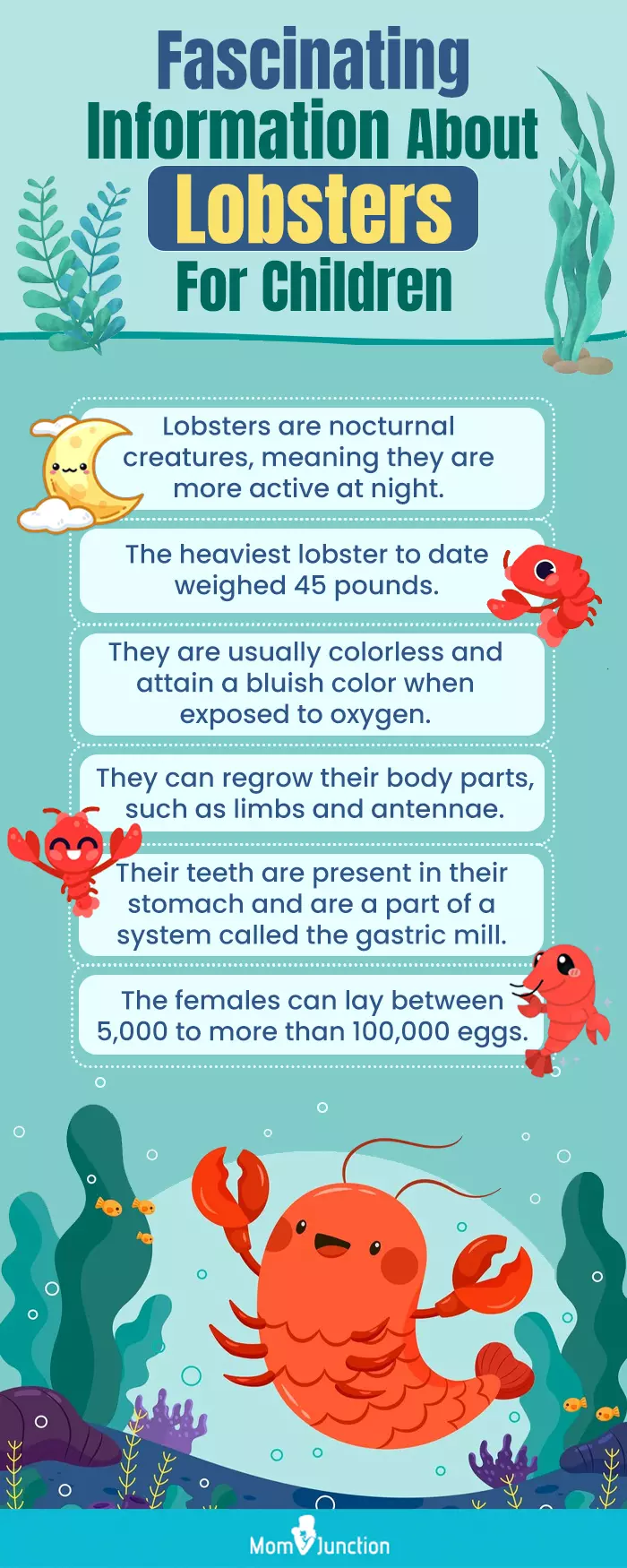
Illustration: Interesting Lobster Facts For Kids
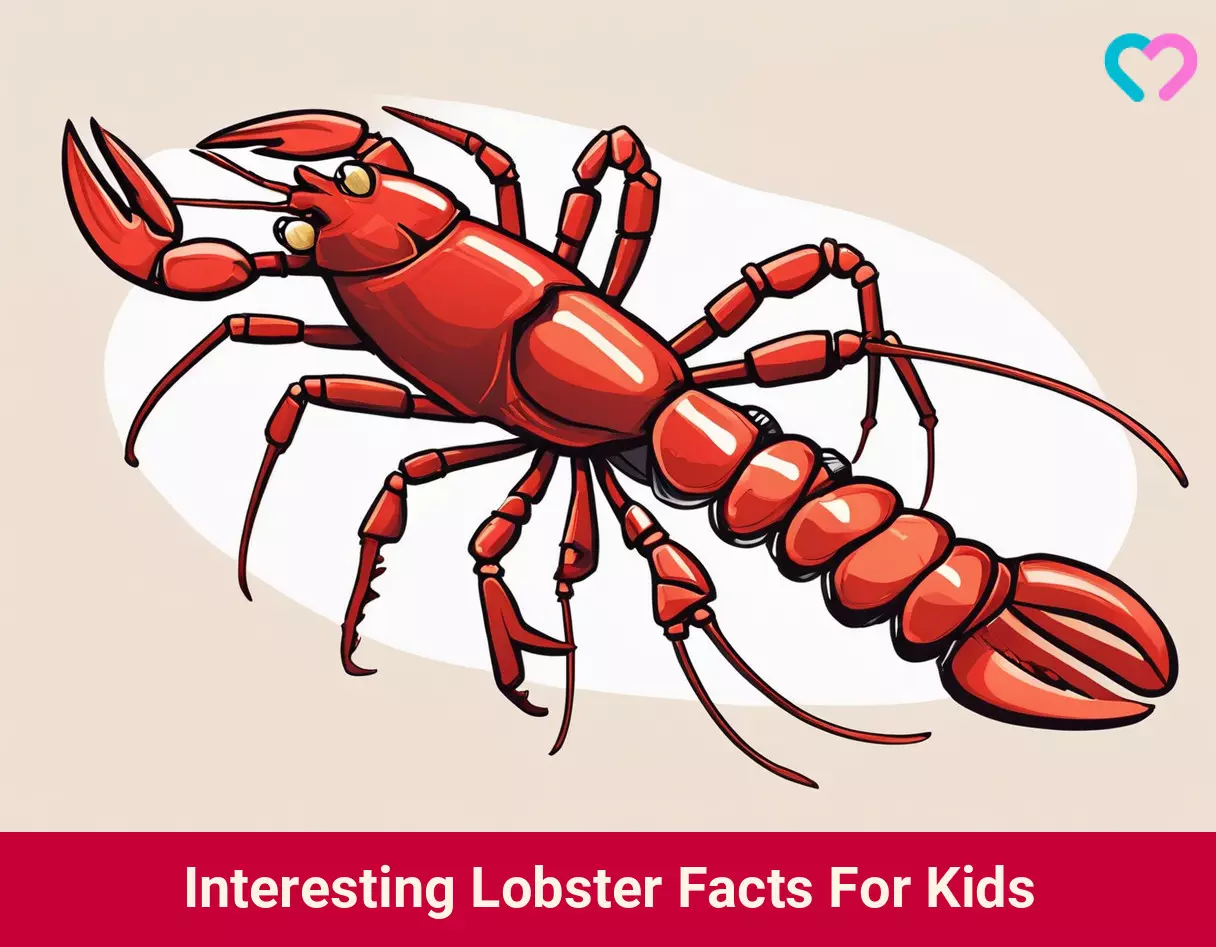
Image: Stable Diffusion/MomJunction Design Team
Lobsters are some of the most unique animals of water. This video will take you through many amazing facts about different types of lobsters and their depiction in mythology.
References
- American Lobster.
https://www.americanoceans.org/species/american-lobster/ - Lobster Institute.
https://umaine.edu/lobsterinstitute/educational-resources/anatomy-biology/ - Types of Lobster.
https://thekitchencommunity.org/types-of-lobster/ - The First Record Of A Rare Blue Phenotype In The Brown Spiny Lobster Panulirus Echinatus Smith 1869 (Decapoda: Palinuridae)
http://panamjas.org/pdf_artigos/PANAMJAS_16(2)_123-128.pdf - The American Lobster.
https://web.archive.org/web/20100310113207/http://www.osl.gc.ca/homard/en/faq.html - The Vital Role of Lobsters and Conchs in Reef Ecosystems.
https://coral.org/en/blog/the-vital-role-of-lobsters-and-conchs-in-reef-ecosystems/#:~:text=Food%20Chain%20Dynamics%20%E2%80%93%20A%20crucial,stability%20of%20the%20food%20web.
Community Experiences
Join the conversation and become a part of our nurturing community! Share your stories, experiences, and insights to connect with fellow parents.
Read full bio of Theresa Bertuzzi
Read full bio of Manjiri Kochrekar
Read full bio of Harshita Makvana
Read full bio of Trisha Chakraborty













